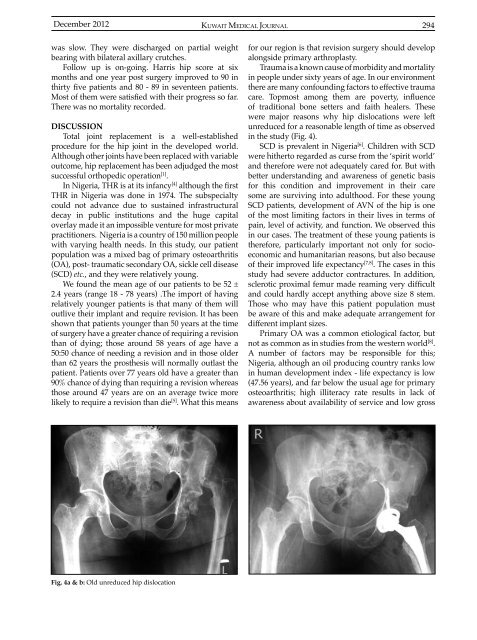Vol 44 # 4 December 2012 - Kma.org.kw
Vol 44 # 4 December 2012 - Kma.org.kw
Vol 44 # 4 December 2012 - Kma.org.kw
You also want an ePaper? Increase the reach of your titles
YUMPU automatically turns print PDFs into web optimized ePapers that Google loves.
<strong>December</strong> <strong>2012</strong><br />
KUWAIT MEDICAL JOURNAL 294<br />
was slow. They were discharged on partial weight<br />
bearing with bilateral axillary crutches.<br />
Follow up is on-going. Harris hip score at six<br />
months and one year post surgery improved to 90 in<br />
thirty five patients and 80 - 89 in seventeen patients.<br />
Most of them were satisfied with their progress so far.<br />
There was no mortality recorded.<br />
DISCUSSION<br />
Total joint replacement is a well-established<br />
procedure for the hip joint in the developed world.<br />
Although other joints have been replaced with variable<br />
outcome, hip replacement has been adjudged the most<br />
successful orthopedic operation [1] .<br />
In Nigeria, THR is at its infancy [4] although the first<br />
THR in Nigeria was done in 1974. The subspecialty<br />
could not advance due to sustained infrastructural<br />
decay in public institutions and the huge capital<br />
overlay made it an impossible venture for most private<br />
practitioners. Nigeria is a country of 150 million people<br />
with varying health needs. In this study, our patient<br />
population was a mixed bag of primary osteoarthritis<br />
(OA), post- traumatic secondary OA, sickle cell disease<br />
(SCD) etc., and they were relatively young.<br />
We found the mean age of our patients to be 52 ±<br />
2.4 years (range 18 - 78 years) .The import of having<br />
relatively younger patients is that many of them will<br />
outlive their implant and require revision. It has been<br />
shown that patients younger than 50 years at the time<br />
of surgery have a greater chance of requiring a revision<br />
than of dying; those around 58 years of age have a<br />
50:50 chance of needing a revision and in those older<br />
than 62 years the prosthesis will normally outlast the<br />
patient. Patients over 77 years old have a greater than<br />
90% chance of dying than requiring a revision whereas<br />
those around 47 years are on an average twice more<br />
likely to require a revision than die [5] . What this means<br />
for our region is that revision surgery should develop<br />
alongside primary arthroplasty.<br />
Trauma is a known cause of morbidity and mortality<br />
in people under sixty years of age. In our environment<br />
there are many confounding factors to effective trauma<br />
care. Topmost among them are poverty, influence<br />
of traditional bone setters and faith healers. These<br />
were major reasons why hip dislocations were left<br />
unreduced for a reasonable length of time as observed<br />
in the study (Fig. 4).<br />
SCD is prevalent in Nigeria [6] . Children with SCD<br />
were hitherto regarded as curse from the ‘spirit world’<br />
and therefore were not adequately cared for. But with<br />
better understanding and awareness of genetic basis<br />
for this condition and improvement in their care<br />
some are surviving into adulthood. For these young<br />
SCD patients, development of AVN of the hip is one<br />
of the most limiting factors in their lives in terms of<br />
pain, level of activity, and function. We observed this<br />
in our cases. The treatment of these young patients is<br />
therefore, particularly important not only for socioeconomic<br />
and humanitarian reasons, but also because<br />
of their improved life expectancy [7,8] . The cases in this<br />
study had severe adductor contractures. In addition,<br />
sclerotic proximal femur made reaming very difficult<br />
and could hardly accept anything above size 8 stem.<br />
Those who may have this patient population must<br />
be aware of this and make adequate arrangement for<br />
different implant sizes.<br />
Primary OA was a common etiological factor, but<br />
not as common as in studies from the western world [8] .<br />
A number of factors may be responsible for this;<br />
Nigeria, although an oil producing country ranks low<br />
in human development index - life expectancy is low<br />
(47.56 years), and far below the usual age for primary<br />
osteoarthritis; high illiteracy rate results in lack of<br />
awareness about availability of service and low gross<br />
Fig. 4a & b: Old unreduced hip dislocation
















